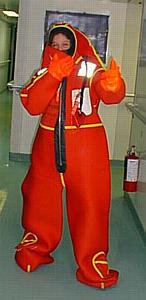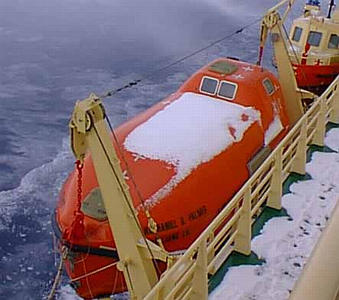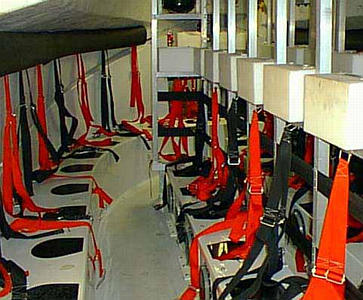
|
|
25 February, 1999
February 25, 1999
Hello from the Amundsen Sea! Today, we finished our multibeam survey in
Suzlberger Bay and then ran a seismic line for a few hours. We were
looking for a place to core, and we found a potential site. Since we
weren't sure how much soft mud was on the bottom, we took a grab sample to
test it out. Guess what we found? Gravel and rocks! So, that means we
could not take a piston core in the area. Afterwards, we took off for our
next location. We are currently in transit to the Getz Ice Shelf. It will
take us about 48 hours to get there. We will continue multibeaming along
the way, and of course we will continue taking the log every 15 minutes.
Other than that, I bet things will be pretty quiet around here tomorrow.
As a result of our long transit, Dr. Anderson and Captain Joe decided that
this would be a good time to try and get our time zones straightened out.
Did you remember that I was on the same time as New Zealand . . . 18 hours
ahead of Indiana? Well, several days ago we passed the 180 degree
longitude line. That line is called the International Date Line, and the
day changes as you go from one side of the line to the other. Well, it was
a bad time in our data collection to switch the day, so we waited until
today to do it. So, we actually had two Wednesdays here on the ship --
yesterday and today. Yesterday, we were 18 hours ahead of the time at
home, and now we are 6 hours behind. Due to the fact that it would make
the journal calendars very weird, I'll keep writing the journals like this
never happened. As we continue around the continent, the time zones will
also change. Time zones change every 15 degrees of longitude, just like
they do as you drive from the west coast to the east coast of the United
States. Tonight, we are going to move our clocks ahead one hour. When we
wake up tomorrow morning, we will be only 5 hours behind the time in
Indiana! When we finally reach Palmer Station, we will be on Palmer
Station time (which is only an hour or two different from the time at
home).
Well, we were going to talk about emergency drills today. Yesterday's
question was "Where do you suppose we have to go for an emergency drill?
What should we take with us?" On the Palmer, we have emergency drills
every week to make sure we would know what to do in case we had to evacuate
the ship. Our second emergency drill was yesterday afternoon. When the
alarm sounds, we have to go to our rooms and get our life jackets and our
immersion suits (which we call "gumby suits"). Our gumby suits are big,
plastic, orange suits that are designed to protect us from the cold water.
They are made of a material very similar to what scuba divers wear -- but
it's thicker, much more buoyant, and it stays dry inside. They are very
bulky, and they zip up to cover our entire body (except our face). Our
gumby suits are actually life preservers, too, but it takes about 1-2
minutes to awkwardly get inside of them. The life preservers are with us
in case we wouldn't have time to get into our gumby suits. We also grab
our red parka, a hat, some mittens, and a pair of socks in case we would
need to stay extra warm. Most of us have those little things packed into
our gumby suit bag.
Once we get our life jackets, gumby suits, and warm clothes, we have to go
up to the third deck conference room where attendance is taken. The reason
that we have to go all the way up to the third deck is that the life boats
can be easily boarded from there. If we were going to have to evacuate the
ship, we would then put on our gumby suits and get into the life boats.
The life boats are amazing! There are two life boats on the Nathaniel B.
Palmer, and they are located on opposite sides of the ship. Each one
contains everything needed to support 76 people. Since the ship is only
allowed to have a maximum of 70 people on it at any one time, there's
plenty of room (although everyone would be tightly packed). In the case of
a real emergency, each life boat is equipped with water, condensed milk,
and life boat rations of food (like special granola bars) for everybody.
There are also first aid kits, lanterns, flares, radios, and enough diesel
fuel to run the engines at 6 knots for 24 hours. Most people are surprised
to see what the life boats look like -- they are totally enclosed! It
makes sense that they are totally enclosed because it's so cold here in
Antarctica. Another neat feature is that they could right themselves in
the water if they rolled over. There are windows, and there are also some
small holes that can be opened (if needed) for the oars to stick through.
The life boats are tested frequently, but the Nathaniel B. Palmer has never
had to evacuate its passengers for a real emergency.
Today we saw lots more ice -- both sea ice and icebergs. We also saw lots
more Adelie and Emperor penguins. How many different species of penguins
are there? Do all of them live in Antarctica? We'll look at that in
tomorrow's journal. Keep the questions coming . . . I love hearing from
you!
Kim Giesting
Latitude: 75 degrees 54 minutes South
Longitude: 151 degrees 12 minutes West
Temperature: -8 degrees C
Barometer: 982 mb
Wind Speed: 10 knots
Wind Direction: 145 degrees (from the Southeast)
Sunrise Today: 02:24
Sunset Today: 19:59

This is Hannah modeling her gumby suit.

This is the outside of the life boat. It has a little bit of snow on top.

This is the inside of the life boat.
Contact the TEA in the field at
.
If you cannot connect through your browser, copy the
TEA's e-mail address in the "To:" line of
your favorite e-mail package.
|
